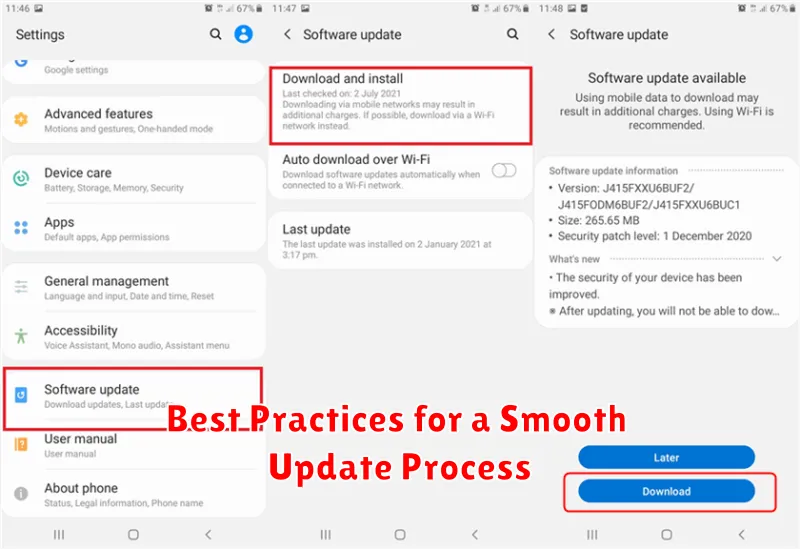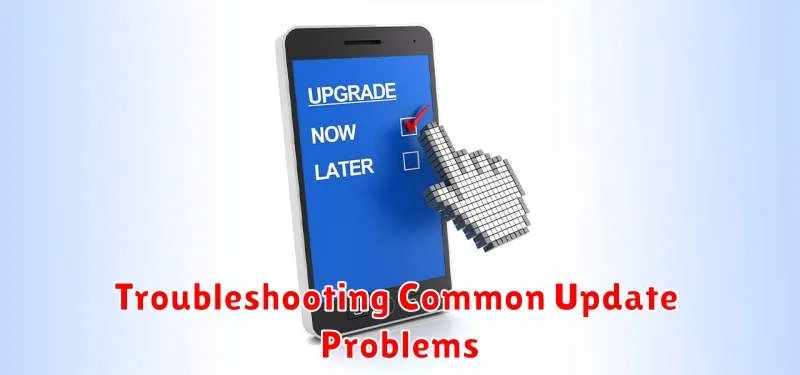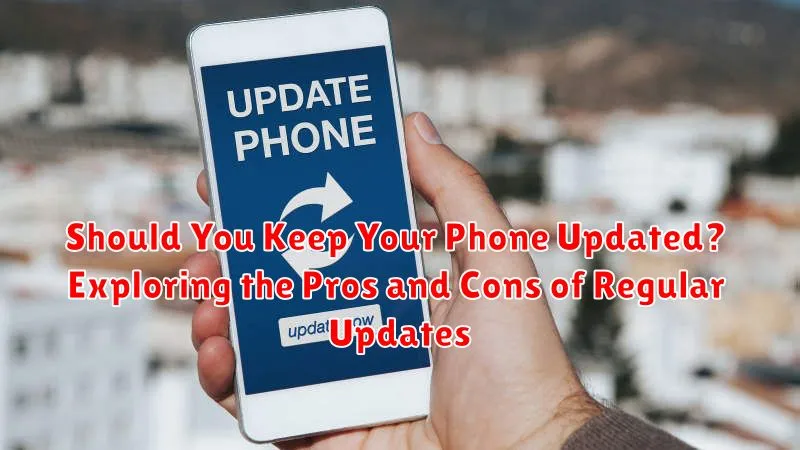In today’s fast-paced digital world, our smartphones have become indispensable tools. We rely on them for communication, productivity, entertainment, and so much more. A crucial aspect of maintaining optimal smartphone performance and security is keeping the operating system and apps updated. But is diligently installing every update truly necessary? This article delves into the pertinent question: Should you keep your phone updated? We will explore the pros and cons of regular phone updates, weighing the benefits against the potential drawbacks to help you make informed decisions about your device.
Staying on top of the latest phone updates can be beneficial, offering enhancements like improved security, bug fixes, and exciting new features. However, updating your phone isn’t always a seamless experience. Potential downsides include compatibility issues with older apps, decreased battery life, and the occasional performance hiccup. Understanding the pros and cons of regular updates empowers you to decide whether to embrace the latest upgrade or stick with a familiar, albeit potentially less secure, version of your phone’s software. We will examine both sides of this important debate, providing you with the information you need to determine the best update strategy for your specific needs.
The Importance of Software Updates
Software updates play a crucial role in maintaining the health and functionality of your phone. They are designed to address a range of issues and provide improvements to the overall user experience. Think of them as essential tune-ups for your device’s software.
Regular updates contribute significantly to the longevity and performance of your phone. They ensure that your device remains compatible with evolving technology and continues to operate smoothly.
Ignoring software updates can leave your phone vulnerable to various problems and limit its potential. By keeping your phone updated, you are investing in its continued optimal performance and extending its usable lifespan.
Security Enhancements and Bug Fixes
A primary reason for diligently updating your phone’s software is the critical security patches these updates deliver. Cybersecurity threats are constantly evolving, and updates often include fixes for newly discovered vulnerabilities. These vulnerabilities, if left unpatched, could allow malicious actors to access your personal data, install malware, or even take control of your device.
Beyond security enhancements, updates also address bug fixes. Bugs are software errors that can cause a range of issues, from minor performance hiccups like app crashes to more significant problems impacting functionality. Regular updates squash these bugs, ensuring a smoother and more reliable user experience.
Performance Improvements and New Features
Beyond security and bug fixes, updates often bring performance enhancements. Developers continually optimize software to run more efficiently on devices. Updates can lead to faster app loading times, smoother multitasking, and improved battery life.
Additionally, updates frequently introduce new features to enhance the user experience. These features can range from small improvements to major additions. Examples include new camera modes, updated user interfaces, and integration with other services.
Staying updated allows you to take advantage of these performance improvements and experience the latest features offered by your phone’s operating system and apps. This contributes to a more satisfying and efficient user experience overall.
Potential Risks and Drawbacks of Updating
While software updates generally bring improvements, they can also introduce certain risks. Data loss, although rare, is a possibility during the update process. It’s crucial to back up your data before initiating any updates.
Unexpected bugs can sometimes appear after an update. These can range from minor glitches to significant performance issues. While developers strive to thoroughly test updates, unforeseen issues can occasionally arise in real-world usage scenarios.
Updates can also lead to reduced battery life, especially immediately following the update as the phone re-indexes and optimizes data. This is usually temporary, but in some cases, the drain might persist.
Furthermore, some updates might require more storage space. If your phone’s storage is already limited, an update could lead to storage issues. Downgrading to a previous version is not always straightforward, and in some cases, it might not be an option.
Compatibility Issues with Apps and Accessories
While updates generally aim to improve compatibility, there are instances where an update can inadvertently cause issues with certain apps or accessories. Older apps, particularly those that haven’t been actively maintained by their developers, might encounter problems functioning correctly with a newer operating system. This can manifest as glitches, crashes, or the app becoming entirely unusable.
Hardware accessories can also be affected. A software update might change how the phone communicates with connected devices, leading to incompatibility issues with Bluetooth devices, charging docks, or other peripherals. This can be particularly frustrating if a previously reliable accessory stops working after an update. While accessory manufacturers usually release updates to address these issues, it’s not always guaranteed, and the process can take time.
Data Usage and Storage Considerations
Updating your phone’s operating system (OS) and apps often requires a significant amount of data. Downloading updates can consume a large portion of your monthly data allowance, especially if you’re not connected to Wi-Fi. Consider the implications if you have a limited data plan.
Storage space is another crucial factor. Updates typically require free space on your device’s internal storage to download and install. If your phone is already low on storage, you may need to delete files or apps before proceeding with an update. The size of updates can vary greatly, so it’s important to check the update size before initiating the download.
Some updates might even require more storage space after installation than the previous version. While less common, this can occur when new features or functionalities are added. Therefore, routinely checking your available storage is a recommended practice.
Managing Update Notifications and Scheduling
Staying on top of phone updates doesn’t have to be a disruptive process. Modern operating systems offer a variety of tools to manage notifications and schedule updates conveniently.
Notification Control: Most phones allow you to customize how and when you receive update notifications. You can choose to be alerted immediately, receive a summary of pending updates, or even silence notifications entirely until a convenient time.
Scheduled Updates: Many devices enable users to schedule updates for specific times, often overnight. This ensures the update process occurs when the phone is not in use, minimizing disruption to your daily routine.
Automatic Updates: For a truly hands-off approach, enabling automatic updates allows your phone to download and install updates in the background without requiring any manual intervention. This is often the simplest way to ensure your device remains current.
By understanding and utilizing these features, you can maintain an up-to-date device without unnecessary interruptions.
Best Practices for a Smooth Update Process

Updating your phone’s software doesn’t have to be a hassle. Follow these best practices to ensure a smooth and trouble-free experience.
Back Up Your Data
Before initiating any update, back up your important data. This includes photos, videos, contacts, and other files you don’t want to lose. Backing up to a cloud service or computer provides an extra layer of security should anything go wrong during the update process.
Connect to a Stable Wi-Fi Network
Downloading updates over a cellular network can incur data charges and may be interrupted. Use a reliable Wi-Fi connection for a faster and more stable download.
Ensure Sufficient Battery Life
Make sure your phone has enough battery life before starting an update. Ideally, your phone should be fully charged or connected to a power source during the process. An interruption due to low battery can lead to update failures.
Restart Your Phone
After the update is complete, restart your phone. This helps to clear any temporary files and ensures the new software is properly implemented.
Troubleshooting Common Update Problems

Occasionally, you might encounter issues during the update process. Here are some common problems and how to address them:
Insufficient Storage Space
If you see an error message related to low storage, free up space by deleting unnecessary files, apps, or clearing your browser cache. A good rule of thumb is to have at least double the update size available.
Slow Download or Installation
A slow or stalled update can be frustrating. Ensure you have a stable internet connection, preferably Wi-Fi. Try pausing and resuming the download, or restarting your phone.
Update Failure
If the update fails entirely, try restarting your device and attempting the update again. If the problem persists, consider contacting your device manufacturer’s support for assistance, as it might indicate a more serious issue.
Battery Drain After Update
Sometimes, a new update can temporarily increase battery drain while the system optimizes itself. This is often resolved within a few days. If it persists, check your battery usage in settings to identify any power-hungry apps and consider recalibrating your battery by letting it fully discharge and then fully charging it.

